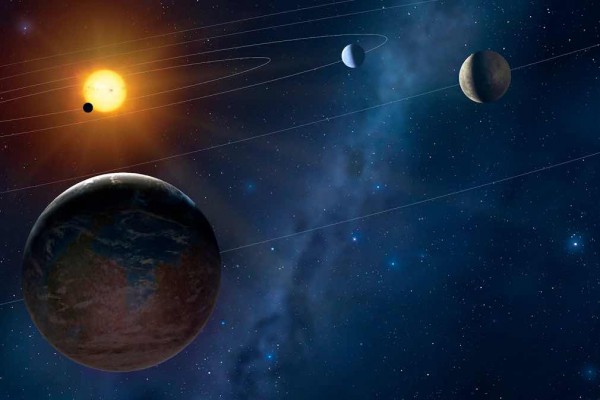A month ago, we published an article about the Cannae-Drive, which was invented by Guido Fetta, and tested by NASA over an eight day testing campaign that took place in August of 2013. It’s also known as the EM drive. It showed that a small amount of thrust was achieved inside a container without the use of any fuel. The results were then presented at the 50th Joint Propulsion Conference in Cleveland, Ohio.
Article by Arjun Walia
You can access the paper (titled “Numerical and Experimental Results for a Novel Propulsion Technology Requiring no On-Board Propellant”) that was presented at the conference here, and inventor Guido Fetta’s paper here.
2016 has been a huge year for the EM drive, primarily because it was recently announced that it’s about to be tested in space, and NASA researchers reported a successful 10-week trial of their EM drive prototype, which led to the approval of Fetta being granted permission to test his own version in space.
Now, even more recently, the latest patent application for the new kind of rocket engine that generates thrust without any kind of exhaust or propellant was just released by the U.K. Intellectual Property office by investor Roger Shawyer (source).
“The patent process is a very significant process, it’s not like an academic peer review where everyone hides behind an anonymous review, it’s all out in the open,” Shawer told Marry-Ann Russon at the International Business Times.
He went on to say that “this is a proper, professional way of establishing prior ownership done by professionals in the patent office, and in order to publish my patent application, they had to first carry out a thorough examination of the physics in order to establish that the invention does not contravene the laws of physics.”
Utilizing electromagnetic waves as fuel, the EM drive creates thrust by bouncing microwave photons back and forth in a cone-shaped metal cavity.
Now, Newton’s Third Law states that without exhaust you can’t produce thrust, or if something needs an “equal and opposite reaction,” something needs to be coming out of the back of the propulsion system to push it forward, and the EM drive doesn’t have that.
It’s called the law of conservation of momentum, but this invention taps into the ‘zero-point‘ field of energy/electromagnetic waves.
By the way, the laws of physics need to be changed to account for the fact that space is not empty.
Experiments from a number of researchers from around the world and NASA have shown that it can indeed produce thrust with enough power to propel a spacecraft.
This has huge implications. Think about it—propulsion systems that require no fuel.
Apparently, Shawyer is now working with a U.K. aerospace agency that will produce even more thrust, greater than what NASA and other researchers have already observed (source).
This is exciting because it basically proves that we have a limitless resource of energy to tap into and utilize for space travel. This is currently the biggest barrier for modern day space travel and exploration.
Science needs to be careful and stray far from getting caught up in the grip of scientific dogma. History has constantly shown us, especially within the realms of science, that what we accept as real always changes at another point in time. Our understanding and knowledge regarding the nature of our reality is constantly changing.
“There is nothing new to be discovered in physics now. All that remains is more and more precise measurement.” This statement (worldview statement) was made by Lord Kelvin in 1900, which was shattered five years later when Einstein published his paper on special relativity.
Today, engineers are inventing power generators that utilize these concepts, like Paramahamsa Tewari.
“These are not just fringe scientists with science fiction ideas. They are mainstream ideas being published in mainstream physics journals and being taken seriously by mainstream military and NASA type funders. I’ve been taken out on aircraft carriers by the Navy and shown what it is we have to replace if we have new energy sources to provide new fuel methods.” – Dr. Harold E. Puthoff, director of the Institute for Advanced Studies at Austin (source)
Invention Secrecy and The Problem With Patents
Did you know that invention secrecy is at an all time high?
Did you know that the U.S. Government classifies over 500 million pages of documents each year? Justification for the mass classification of information is (apparently) done for the sake of “national security,” but as we know:
“The dangers of excessive and unwarranted concealment of pertinent facts far outweigh the dangers that are cited to justify them. There is a very grave danger that an announced need for an increased level of security will be seized upon by those anxious to expand its meaning to the very limits of censorship and concealment. That I do not tend to permit, so long as it’s in my control.” – JFK (source)
The U.S. Patent and Trademark Office is supposed to legally protect the inventions of entrepreneurs and companies, some of whom have developed groundbreaking technology. Unfortunately, it doesn’t work that way, as a number of documents obtained via the Freedom of Information Act (FOIA) reveal how the Patent Office has been using a secret system to withhold the approval of some applications.
A great example comes in the form of a 50-page document that was obtained by Kilpatrick Towsend & Stockton, LLP, who commonly represent major tech companies that include Apple, Google, and Twitter (to name a few). You can view that entire document HERE.
The program delaying patent applications is called the Sensitive Application Warning System (SWAS). Usually, when an application is submitted for a patent approval, it requires a couple of examiners who work with the Patent office to go through their process of approval. This process usually takes approximately 1 to 2 years, but applications that are filed in SAWS must be approved by several people, and can be delayed for a number of years.
One great example (out of many) of delayed patent applications comes from Dr. Gerald F. Ross. He filed a patent application for a new invention he had devised to defeat the jamming of electromagnetic transmissions at specified frequencies. It was not until June 17, 2014 (almost 37 years later) that this patent was granted (source).
According to the Federation of American Scientists, a group of renowned scientists from various fields that was founded by many of the Manhattan Project scientists who wanted to prevent nuclear war, there were more than 5000 inventions that were under secrecy orders at the end of Fiscal Year 2014 (source).
This is all made possible by something called the “Invention Secrecy Act.” It was written up in 1951 and states that patent applications on new inventions can be subject to secrecy orders. These orders can restrict their publication if government agencies believe that their disclosure would be harmful to national security (source)(source).
As mentioned earlier, “national security” has become an excuse and justification for the classification of a large amount of information on a variety of topics that the public is deliberately kept in the dark about. Apparently, many of these projects and inventions go far above and beyond presidential knowledge.
“It is ironic that the U.S. should be fighting monstrously expensive wars allegedly to bring democracy to those countries, when it itself can no longer claim to be called a democracy when trillions, and I mean thousands of billions of dollars, have been spent on projects which both congress and the commander in chief know nothing about.” – Paul Hellyer, Former Canadian Defence Minister (source)
We don’t really know what other type of technologies are under restriction under the Invention Secrecy Act, but a previous list from 1971 was obtained by researcher Michael Ravnitzky. Most of the technology listed seems to be related to various military applications. You can view that listHERE (source).
As Steven Aftergood from the Federation of American Scientists reports:
“The 1971 list indicates that patents for solar photovoltaic generators were subject to review and possible restriction if the photovoltaics were more than 20% efficient. Energy conversion systems were likewise subject to review and possible restriction if they offered conversion efficiencies in excess of 70-80%” (source).
















